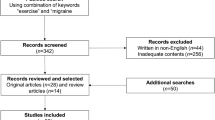Abstract
Several lines of evidence affirm a positive role for exercise in the management of migraine. This review highlights the latest research supporting this view, covering not only its epidemiologic aspects but also the pain modulatory systems that are likely to be engaged by exercise. Recent research provides broad and consistent evidence indicating that cardiovascular exercise can activate multiple pain modulatory mechanisms, if not the underlying mechanisms that initiate the attack. Specifically, a synthesis of independent lines of recent research would indicate that exercise activates endogenous neurotransmitter signals that could be effective in reducing the intensity of migraine pain, though it may not have a direct effect on its overall frequency or duration.
Similar content being viewed by others
References
Papers of particular interest, published recently, have been highlighted as: • Of importance, •• Of major importance
Buse DC, Manack A, Serrano D, et al. Sociodemographic and comorbidity profiles of chronic migraine and episodic migraine sufferers. J Neurol Neurosurg Psychiatry. 2010;81:428–32.
• Varkey E, Hagen K, Zwart JA, et al. Physical activity and headache: results from the Nord-Trondelag Health Study (HUNT). Cephalalgia. 2008;28:1292–7. This report describes the epidemiological evidence that shows an association between headache and sedentary lifestyle.
Varkey E, Cider A, Carlsson J, et al. A study to evaluate the feasibility of an aerobic exercise program in patients with migraine. Headache. 2009;49:563–70.
•• Varkey E, Cider A, Carlsson J, et al. Exercise as migraine prophylaxis: a randomized study using relaxation and topiramate as controls. Cephalalgia. 2011;31:1428–38. This report highlights the many challenges in obtaining direct evidence for exercise as an intervention for migraine therapy.
Tfelt-Hansen P, Block G, Dahlof C, et al. Guidelines for controlled trials of drugs in migraine: second edition. Cephalalgia. 2000;20:765–86.
Hougaard A, Tfelt-Hansen P. Are the current IHS guidelines for migraine drug trials being followed? J Headache Pain. 2010;11:457–68.
Dittrich SM, Gunther V, Franz G, et al. Aerobic exercise with relaxation: influence on pain and psychological well-being in female migraine patients. Clin J Sport Med. 2008;18:363–5.
• Busch V, Gaul C. Exercise in migraine therapy–is there any evidence for efficacy? A critical review. Headache. 2008;48:890–9. This is a structured review of the literature on migraine and exercise, of interest to those who want to read further on this topic.
Staud R, Robinson ME, Price DD. Isometric exercise has opposite effects on central pain mechanisms in fibromyalgia patients compared with normal controls. Pain. 2005;118:176–84.
• Nijs J, Roussel N, Van Oosterwijck J, et al. Fear of movement and avoidance behaviour toward physical activity in chronic-fatigue syndrome and fibromyalgia: state of the art and implications for clinical practice. Clin Rheumatol. 2013;32:1121–9. This is a sampling from a much larger literature on exercise and pain, addressing some of the significant barriers that patients face in getting on board with exercise.
•• Raichlen DA, Foster AD, Gerdeman GL, et al. Wired to run: exercise-induced endocannabinoid signaling in humans and cursorial mammals with implications for the 'runner's high'. J Exp Biol. 2012;215:1331–6. This report provides interesting multi-species data on how cannabinoids can be a rewarding signal that sustains exercise behaviors. Also has an excellent review of the neural systems that are likely engaged by cannabinoids.
Raichlen DA, Foster AD, Seillier A, et al. Exercise-induced endocannabinoid signaling is modulated by intensity. Eur J Appl Physiol. 2013;113:869–75.
Morgan WP. Affective beneficence of vigorous physical activity. Med Sci Sports Exerc. 1985;17:94–100.
• Boecker H, Sprenger T, Spilker ME, et al. The runner's high: opioidergic mechanisms in the human brain. Cereb Cortex. 2008;18:2523–31. This report uses advanced imaging methods to show that endogenous opioid signalling pathways are modulated by sustained exercise.
Sparling PB, Giuffrida A, Piomelli D, et al. Exercise activates the endocannabinoid system. Neuroreport. 2003;14:2209–11.
Dietrich A, McDaniel WF. Endocannabinoids and exercise. Br J Sports Med. 2004;38:536–41.
Lupica CR, Riegel AC. Endocannabinoid release from midbrain dopamine neurons: a potential substrate for cannabinoid receptor antagonist treatment of addiction. Neuropharmacology. 2005;48:1105–16.
Mahler SV, Smith KS, Berridge KC. Endocannabinoid hedonic hotspot for sensory pleasure: anandamide in nucleus accumbens shell enhances 'liking' of a sweet reward. Neuropsychopharmacology. 2007;32:2267–78.
Justinova Z, Yasar S, Redhi GH, et al. The endogenous cannabinoid 2-arachidonoylglycerol is intravenously self-administered by squirrel monkeys. J Neurosci. 2011;31:7043–8.
• Meng ID, Manning BH, Martin WJ, et al. An analgesia circuit activated by cannabinoids. Nature. 1998;395:381–3. This is an important milestone in the connection between cannabinoids and analgesia, that they activate endogenous descending controls of nociceptive responses to peripheral pain in the spinal cord dorsal horn.
Agarwal N, Pacher P, Tegeder I, et al. Cannabinoids mediate analgesia largely via peripheral type 1 cannabinoid receptors in nociceptors. Nat Neurosci. 2007;10:870–9.
Akerman S, Holland PR, Goadsby PJ. Cannabinoid (CB1) receptor activation inhibits trigeminovascular neurons. J Pharmacol Exp Ther. 2007;320:64–71.
• Akerman S, Holland PR, Lasalandra MP, et al. Endocannabinoids in the brainstem modulate dural trigeminovascular nociceptive traffic via CB1 and "Triptan" receptors: implications in migraine. J Neurosci. 2013;33:14869–77. This is the latest in a series of reports that closes the gap between exercise physiology, cannabinoids, and headache pain.
Compliance with Ethics Guidelines
Conflict of Interest
Andrew H. Ahn reported no potential conflicts of interest relevant to this article.
Human and Animal Rights and Informed Consent
This article does not contain any studies with human or animal subjects performed by any of the authors.
Author information
Authors and Affiliations
Corresponding author
Additional information
This article is part of the Topical Collection on Migraine
Rights and permissions
About this article
Cite this article
Ahn, A.H. Why Does Increased Exercise Decrease Migraine?. Curr Pain Headache Rep 17, 379 (2013). https://doi.org/10.1007/s11916-013-0379-y
Published:
DOI: https://doi.org/10.1007/s11916-013-0379-y



